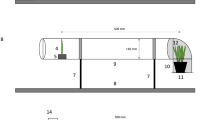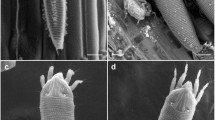Abstract
In successful classical biological control, natural enemies can provide enduring pest suppression if they reproduce and disperse without continued human management. To explain the efficient control exerted on the Asian chestnut gall wasp Dryocosmus kuriphilus Yasumatsu (Hymenoptera: Cynipidae) by the parasitoid Torymus sinensis Kamijo (Hymenoptera: Torymidae), it is required that the latter has the capacity to track the range expansion of its host. In the present study, we hypothesized that the distribution of infested patches and the prevailing wind directions would interactively influence and accelerate the spread of the parasitoid. It emerged that the spread capability of T. sinensis is high and likely affected by a combination of short- and long-distance flights (stratified dispersal). In particular, the ability to disperse long distances represents a successful trait of the parasitoid because the natural dispersal of its host is high and frequently aided by unintentional human-mediated transportation.

Similar content being viewed by others
References
Aoto I, Murakami Y (1992) Dispersion of a Torymus (Syntomaspis) sinensis population in Fukuoka Prefecture (Hymenoptera: Torymidae). Proc Assoc Pl Prot Kyushu 38:193–196
Battisti A, Benvegnù I, Colombari F, Haack RA (2014) Invasion by the chestnut gall wasp in Italy causes significant yield loss in Castanea sativa nut production. Agric Forest Entomol 16:75–79
Bianchi FJJA, Schellhorn NA, van der Werf W (2009) Predicting the time to colonization of the parasitoid Diadegma semiclausum: the importance of the shape of spatial dispersal kernels for biological control. Biol Control 50:267–274
Bonte D, van Dyck H, Bullock JM, Coulon A, Delgado M, Gibbs M, Lehouck V, Matthysen E, Mustin K, Saastamoinen M, Schtickzelle N, Stevens VM, Vandewoestijne S, Baguette M, Barton K, Benton TG, Chaput-Bardy A, Clobert J, Dytham C, Hovestadt T, Meier CM, Palmer SCF, Turlure C, Travis JMJ (2012) Costs of dispersal. Biol Rev 87:290–312
Bosio G, Armando M, Moriya S (2013) Verso il controllo biologico del cinipide del castagno. L’Informatore Agrario 14:60–64
Bowler DE, Benton TG (2005) Causes and consequences of animal dispersal strategies: relating individual behaviour to spatial dynamics. Biol Rev 80:205–225
Collier T, van Steenwyk R (2004) A critical evaluation of augmentative biological control. Biol Control 31:245–256
Compton SG (2002) Sailing with the wind: dispersal by small flying insects. In: Bullock JM, Kenward RE, Hails RS (eds) Dispersal ecology: 42nd symposium of the British ecological society. Blackwell, Oxford, pp 113–133
Cooper WR, Rieske LK (2007) Review of the historic and current status of the Asian chestnut gall wasp in North America. J Am Chestnut Found 21:26–32
Doak P (2000) The effects of plant dispersion and prey density on parasitism rates in a naturally patchy habitat. Oecologia 122:556–567
Dudley R (2002) The biomechanics of insect flight: form, function, evolution. Princeton University Press, Princeton
Ferracini C, Gonella E, Ferrari E, Saladini MA, Picciau L, Tota F, Pontini M, Alma A (2015) Novel insight in the life cycle of Torymus sinensis, biocontrol agent of the chestnut gall wasp. BioControl 60:169–177
Folmer O, Black M, Hoeh W, Lutz R, Vrijenhoek R (1994) DNA primers for amplification of mitochondrial cytochrome C oxidase subunit I from diverse metazoan invertebrates. Mol Mar Biol Biotech 3:294–299
Forthofer JM (2007) Modeling wind in complex terrain for use in fire spread prediction. Fort Collins, CO: Colorado State University, Thesis (123 pp). Available via DIALOG. http://www.firelab.org/document/forthofer-thesis. Cited 16 Dec 2015
Gámez-Virués S, Jonsson M, Ekbom B (2012) The ecology and utility of local and landscape scale effects in pest management. In: Gurr GM, Wratten SD, Snyder WE, Read DMY (eds) Biodiversity and insect pests: key issues for sustainable management. Wiley, Chichester, pp 106–120
Gibbs M, Schönrogge K, Alma A, Melika G, Quacchia A, Stone G, Aebi A (2011) Torymus sinensis: a viable management option for the biological control of Dryocosmus kuriphilus in Europe? BioControl 56:527–538
Gilioli G, Pasquali S, Tramontini S, Riolo F (2013) Modelling local and long-distance dispersal of invasive chestnut gall wasp in Europe. Ecol Model 263:281–290
Graziosi I, Rieske LK (2012) Local spread of an exotic invader: using remote sensing and spatial analysis to document proliferation of the invasive Asian chestnut gall wasp. iForest 5:255–261
Graziosi I, Rieske LK (2013) Response of Torymus sinensis, a parasitoid of the gallforming Dryocosmus kuriphilus, to olfactory and visual cues. Biol Control 67:137–142
Graziosi I, Santi F (2008) Chestnut gall wasp (Dryocosmus kuriphilus): spreading in Italy and new records in Bologna province. Bull Insectol 61:343–348
Greany PD, Ashley TR, Baranowski RM, Chambers DL (1976) Rearing and life history studies on Biosteres (Opius) longicaudatus [Hym.: Braconidae]. Entomophaga 21:207–215
Jones TH, Godfray HCJ, Hassell MP (1996) Relative movement patterns of a tephritid fly and its parasitoid wasps. Oecologia 106:317–324
Kim KS (2008) An analysis of wind patterns to predict aerial dispersal of organisms to New Zealand. In: Froud KJ, Popay AI, Zydenbos SM (eds) Surveillance for biosecurity: pre-border to pest management. New Zealand Plant Protection Society, Hastings, pp 121–126
Legner EF, Bellows TS (1999) Exploration for natural enemies. In: Bellows TS, Fisher TW, Caltagirone LE, Dahlsten DL, Gordh G, Huffaker CB (eds) Handbook of biological control. Academic Press, San Diego, pp 87–101
Leitão AB, Miller J, Ahern J, McGarigal K (2006) Measuring landscapes: a planners handbook. Island Press, Washington
Lovato T, Pecenik G (2012) Three-dimensional modeling of pollutant dispersion in Lake Garda (North Italy). In: Jordán F, Jørgensen SE (eds) Developments in environmental modelling, vol 25. Elsevier, Amsterdam, pp 319–330
McManus ML (1988) Weather, behaviour and insect dispersal. Mem Entomol Soc Can 120(S146):71–94
Meiners T, Obermaier E (2004) Hide and seek on two spatial scales—vegetation structure effects herbivore oviposition and egg parasitism. Basic Appl Ecol 5:87–94
Mitchell A (2005) The ESRI guide to GIS analysis, volume 2: spatial measurements and statistics. ESRI Press, Redlands
Moriya S, Shiga M, Adachi I (2003) Classical biological control of the chestnut gall wasp in Japan. In: van Driesche RG (ed) Proceedings of the 1st international symposium on biological control of arthropods. USDA Forest Service, Washington, pp 407–415
Ôtake A, Shiga M, Moriya S (1984) Colonization of Torymus sinensis Kamijo (Hyrnenoptera: Torymidae), a parasitoid of the chestnut gall wasp, Dryocosmus kuriphilus Yasumatsu (Hymenoptera: Cynipidae) introduced from China. Appl Entomol Zool 19:111–114
Pasek JE (1988) Influence of wind and windbreaks on local dispersal of insects. Agric Ecosyst Environ 22(23):539–554
Piao C, Moriya S (1999) Oviposition of Torymus sinensis Kamijo (Hymenoptera: Torymidae) under natural conditions. Entomol Sci 2:329–334
Root RB (1973) Organization of a plant-arthropod association in simple and diverse habitats: the fauna of collards (Brassica oleracea). Ecol Monogr 43:95–124
Schellhorn NA, Bianchi FJJA, Hsu CL (2014) Movement of entomophagous arthropods in agricultural landscapes: links to pest suppression. Annu Rev Entomol 59:559–581
Shigesada N, Kawasaki K, Takeda Y (1995) Modeling stratified diffusion in biological invasions. Am Nat 146:229–251
Travis JMJ, French DR (2000) Dispersal functions and spatial models: expanding our dispersal toolbox. Ecol Lett 3:163–165
Turchin P (1998) Quantitative analysis of movement: measuring and modeling population redistribution in animals and plants. Sinauer Associated, Sunderland
Vet LEM (2001) Parasitoid searching efficiency links behaviour to population processes. Appl Entomol Zool 36:399–408
With KA, King AW (1999) Dispersal success on fractal landscapes: a consequence of lacunarity thresholds. Landscape Ecol 14:73–82
Wright MG, Hoffmann MP, Chenus SA, Gardner J (2001) Dispersal behavior of Trichogramma ostriniae (Hymenoptera: Trichogrammatidae) in sweet corn fields: implications for augmentative releases against Ostrinia nubilalis (Lepidoptera: Crambidae). Biol Control 22:29–37
Acknowledgments
This work could not have been accomplished without the contribution of many persons to gall collection: we greatly appreciate all the help they gave us. We would like to thank the Veneto Region’s Forest Service (in particular Giovanni Narduzzo) and the associations of chestnut producers for their collaboration. We thank Roberto Luise and Daniele Moro (Friuli Venezia Giulia Region) for providing meteorological data. Special thanks are due to Andrea Orzali for his patience and support. We are grateful to Robert Haack for review comments on an earlier version of this paper. Three anonymous reviewers significantly improved the quality of the manuscript. This study was funded by grants from the Regione del Veneto, Servizi Fitosanitari, and the University of Padova, Italy (60 %).
Author information
Authors and Affiliations
Corresponding author
Additional information
Handling Editor: Josep Anton Jaques Miret.
This research is part of a project devoted to the classical biological control of the Asian chestnut gall wasp (Dryocosmus kuriphilus).
Rights and permissions
About this article
Cite this article
Colombari, F., Battisti, A. Spread of the introduced biocontrol agent Torymus sinensis in north-eastern Italy: dispersal through active flight or assisted by wind?. BioControl 61, 127–139 (2016). https://doi.org/10.1007/s10526-015-9712-1
Received:
Accepted:
Published:
Issue Date:
DOI: https://doi.org/10.1007/s10526-015-9712-1




